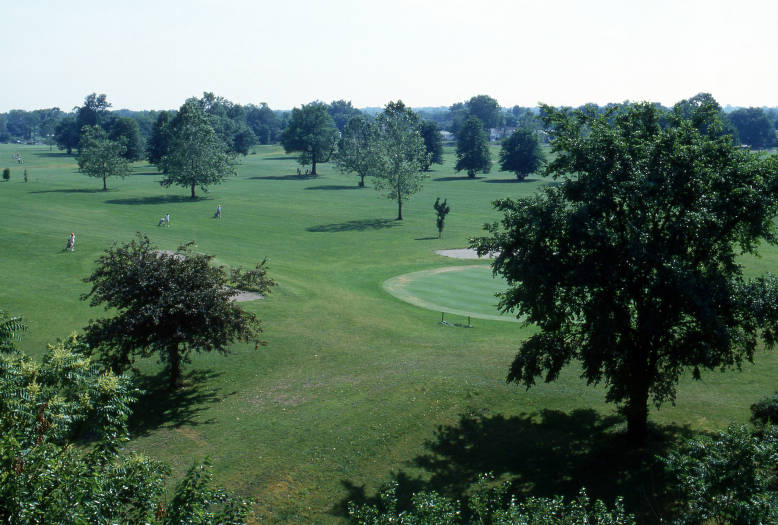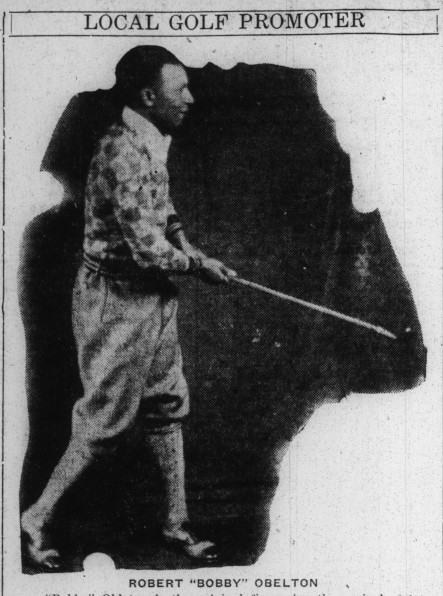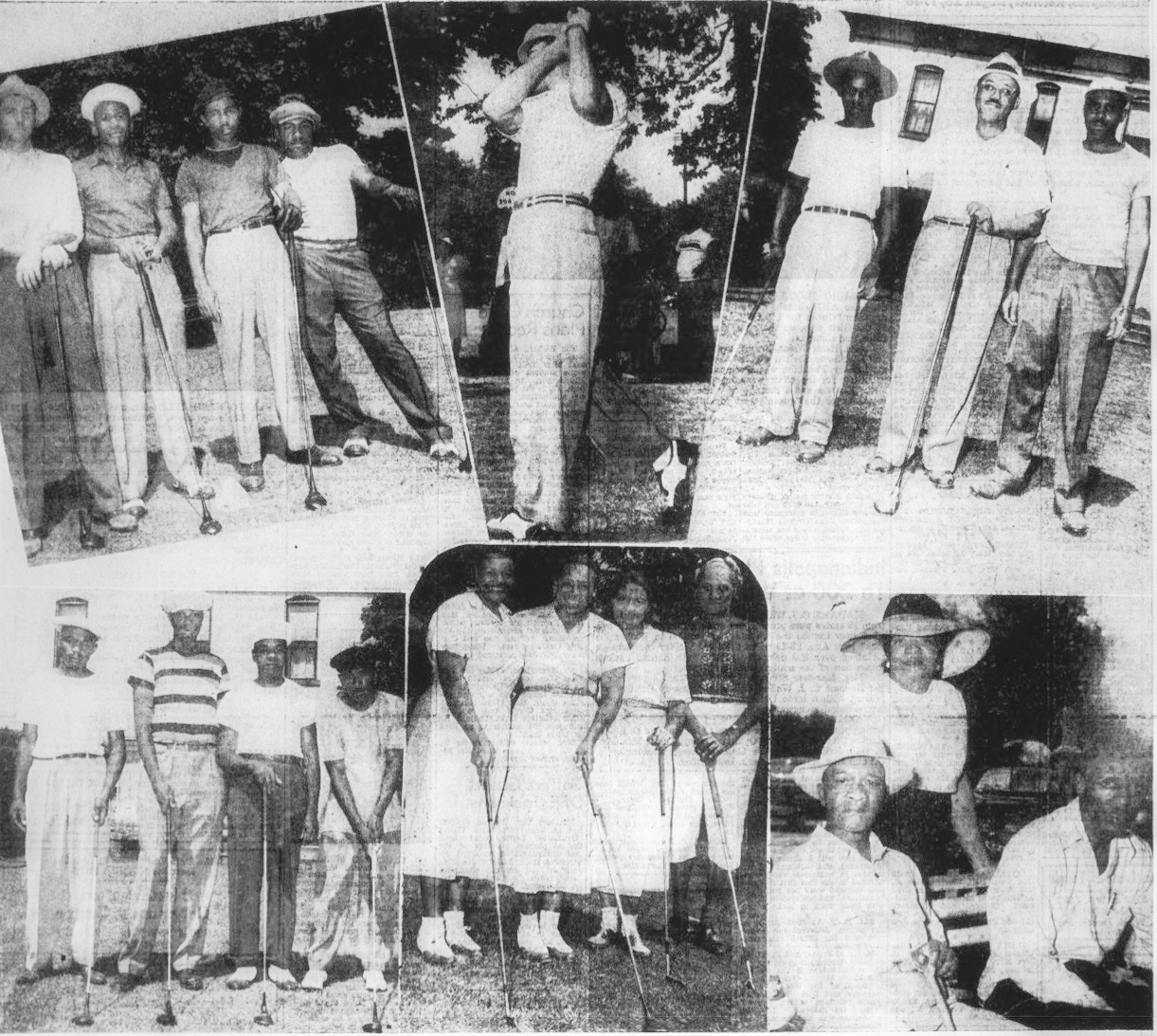African Americans have a rich history of golfing in Indianapolis, but that history was always shaped by segregation. Golf was introduced in the United States at the end of the 19th century, and the Indianapolis Country Club built a two-hole golf course in 1896 that was expanded to nine holes the following year (a course that is now the Woodstock Country Club) (See ). African American Henry Alfred Fleming was a caddie at the club by the turn of the 20th century.

Indianapolis’ first public nine-hole course was built at Riverside Park in 1900, and in 1901 Fleming was appointed as Riverside Park’s golfing instructor. Public facilities were becoming segregated at the turn of the century, though, and in May 1902 Fleming was dismissed.
In 1916, the national Professional Golfers Association decided that membership would only be open to whites (a code that did not change until 1961), so African American golfers formed their own organizations. Founded in 1925, the Colored Golf Association held annual national tournaments from 1925-1928.
By 1925, Indianapolis had four municipal golf courses, but the denied African Americans access to public links. In September 1926, when the Parks Board approved a six-hole course for Douglass Park, the segregated “Jim Crow” park created for African American residents in 1921, the agreed that “Indianapolis Negroes want to play golf.” Nevertheless, the newspaper complained that Blacks were denied access to the city’s proper 18-hole courses.
In 1927, a committee led by African American lawyer successfully campaigned to expand the Douglass Park course to nine holes, and Indianapolis’ Colored Golf Association chapter held its first tournament there that same year.

In January 1928, the Recorder lamented that the poorly maintained course “has plenty of hazards, bunkers and the like, but they are not artificial. They are just as God made the land, rough, uneven, uncut grass, trees in fairways, even the ‘teeing ground’ is like a bunker.” Construction inched along in May 1928, when Indianapolis Recorder columnist and golf booster Morris R. Taylor derided the course as “six tomato cans around the pasture.”
The Colored Golf Association was renamed the United Golfers Association (UGA) in 1929, and national championship tournaments continued through 1941 and resumed after in 1946. The UGA National Negro Open Golf Championship was held at African American courses throughout the country, including Douglass Park in 1932. Riverside Park’s golf instructor in 1901, Henry Fleming was a competitive player for four decades, playing in the UGA national championship in 1935. claimed the title of Indianapolis’ champion in 1930 and 1932. The enormously influential Indiana Avenue club owner served as national secretary of the United Golf Association in 1933.
Douglass Park players claimed seven UGA National Open Women’s Champions. Douglass Park golfer Ella C. Abel competed in the first UGA Open Women’s Championship in 1930 before her first win in the 1934 tournament in Detroit and a repeat championship in 1935. Douglass Park player Lucy Whitehead Williams won the women’s national championship in 1932 after being runner-up three years in a row (she was again runner-up in 1933 and 1934). Williams reclaimed the title in 1936, 1937, 1940, and 1946.
A series of Douglass Park’s men’s players also were successful national players. Former men’s national champion Thomas Edison Marshall moved to Indianapolis and became the Douglass Club pro in 1935. Marshall won the UGA National Championship in 1930 and 1931 and lost the 1932 championship at Douglass Park in a playoff (one of his three runner-up results). Robert “Bobby” Obleton presided over the Colored Golf Association’s Indianapolis chapter in 1927 and taught at a short-lived golf school on in 1927. Obleton was a lifelong golfer who was probably among a very small handful of African Americans in the whole nation who appeared in the 1940 census with an occupation of “professional golfer.”

George Roddy, who moved to Indianapolis to be the golf coach and an industrial arts teacher at segregated , was the first African American on the University of Iowa’s golf team, and he won the UGA National Open Championship amateur division in 1930 before his 1931 graduation. He subsequently coached golf at Arkansas State and North Carolina A&T and again won the UGA National Open Championship’s amateur division in 1937. In 1948, he began his career at Attucks but continued to golf competitively. In 1963, the 55-year-old Roddy became the first African American to win the Indianapolis Golf Association’s city title. He was runner-up in 1964 and reclaimed the title in 1967.
In 1948, the UGA held its tournament at the Coffin Golf Course in Riverside Park, and the organization returned for the 1964 championship, when former heavyweight boxing champion Joe Louis was runner-up for the amateur crown. In the wake of World War II, segregated public courses gradually began to be legally integrated, but Douglass Park continues to be a very active municipal golf course today.
Many private country clubs, however, remained segregated for most of the 20th century. In 1990, the Professional Golf Association (PGA) declared that it would not hold tournaments at courses that discriminated against Black individuals, which led many clubs across the U.S. to open membership to African Americans. As a direct result of this policy, Crooked Stick Golf Club in Carmel recruited its first Black member in 1991 so that it could host the PGA Championship, and Highland finally accepted Black membership in 1992 after a formal complaint to the Indiana Civil Rights Commission.
FURTHER READING
- Mullins, Paul. “Segregating the Fairways: Golfing and Public Leisure in African America.” Archaeology and Material Culture (blog), October 3, 2015. https://paulmullins.wordpress.com/2015/10/03/segregating-the-fairways-golfing-and-public-leisure-in-african-america/.
CITE THIS ENTRY
APA:
Mullins, P. (2022). African American Golf. Encyclopedia of Indianapolis. Retrieved Jan 6, 2026, from https://indyencyclopedia.org/african-american-golf/.
MLA:
Mullins, Paul. “African American Golf.” Encyclopedia of Indianapolis, 2022, https://indyencyclopedia.org/african-american-golf/. Accessed 6 Jan 2026.
Chicago:
Mullins, Paul. “African American Golf.” Encyclopedia of Indianapolis, 2022. Accessed Jan 6, 2026. https://indyencyclopedia.org/african-american-golf/.

Help improve this entry
Contribute information, offer corrections, suggest images.
You can also recommend new entries related to this topic.